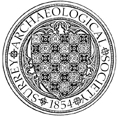The King’s Head, Quarry Street, Guildford
Excavation by GMVEU within the standing building, built c1600, revealed a thick black layer containing material of mid-12th to mid-14th century date. Several features cut into the natural chalk below this layer were also investigated. (292)


